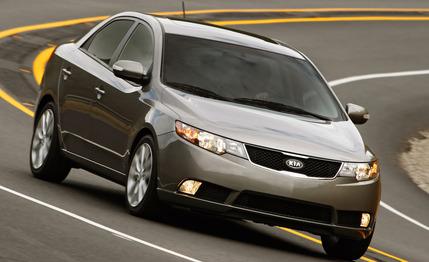 Short Take Road Test
Short Take Road Test
If the compact-car segment were a baseball lineup, the Toyota Corolla and the Honda Civic would be the meat of the order, the third and fourth hitters. They boast home-run sales numbers, long lists of features, and nearly peerless reliability. So where’s the new Kia Forte hitting in this lineup? Any chance it will join these guys at the top of the order? Or does it go immediately to the ninth spot, where its predecessor, the Spectra, languished?
Our top-spec SX test vehicle is powered by a 2.4-liter four-cylinder backed by a so-so five-speed automatic; a six-speed manual is also available. (The Forte LX and EX rely on a 2.0-liter four.) With 173 horses, the SX is more muscular than the larger-displacement Toyota Corolla XRS (158 horsepower) and the Mazda 3 s (167). This makes our recorded zero-to-60 time of 8.6 seconds all the more disappointing; the Kia trails 0.7 second behind the Corolla and 0.9 second behind the Mazda, although both of those cars were equipped with manual gearboxes.
The Forte’s roadholding and 70-to-0-mph braking numbers were much more respectable, at 0.85 g and 173 feet, respectively; its braking is among the best we’ve seen in the current batch of compacts. Using that 2010 Mazda 3 s for comparison, the Kia matched it on the skidpad and actually stopped three feet shorter.
All Fortes, including the $14,390 base LX, have Bluetooth phone connectivity with steering-wheel controls, Sirius radio, USB and auxiliary jacks, four-wheel disc brakes, and stability control. The SX gets larger front brakes, 17-inch alloy wheels, fog lamps, and a telescoping function for the steering wheel. Add heated leather seats ($1000) and a sunroof ($600), and you arrive at our fully loaded tester, which rang in at $20,490.
Equipment-wise, the Kia is very strong, but for enthusiastic driving, it’s not quite there. The SX has firmer springs, retuned shocks, and a larger front anti-roll bar compared with the lower trim levels’. The sum of that equipment, however, isn’t something we’d really call sporty. Turn-in is fairly aggressive, which is nice, but the car begins to plow by midcorner like it’s the start of planting season. The steering requires correction to maintain a line in curves and stay in your lane on the freeway.
But this segment is about inexpensive, comfortable, roomy, inoffensive, and—increasingly—stylish cars, and that is exactly what the Forte is. It doesn’t invite aggressive driving, but that’s all the better to enjoy the well-appointed, airy interior and the relatively supple ride.
So the Forte won’t be displacing the Honda and Toyota sluggers from the heart of the batting lineup, but we could see it hitting second, the place for solid and trustworthy players. It’s just too bad the Forte isn’t more fun to drive; a car that can be counted on for singles could have instead been hitting base-clearing doubles.